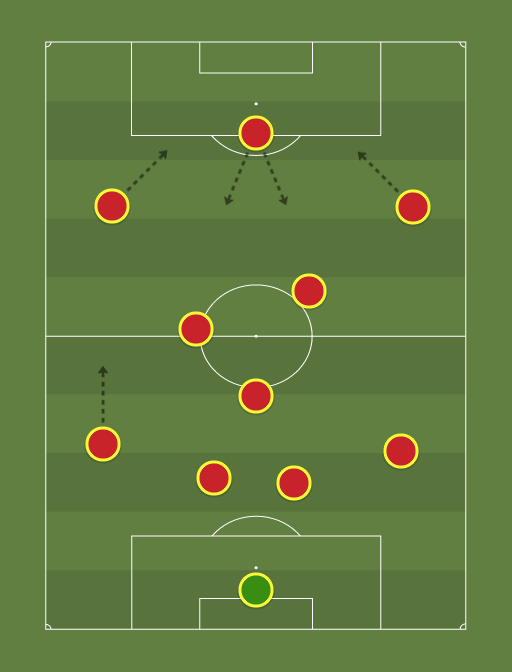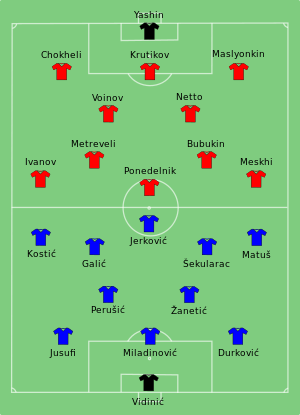All players shall be judged only on their performances at the tournaments (From 1927 to 1960 the CEICs, from 1960 to 2012 the Euros). Please take this into account before voting. You can read up on the theme by clicking here.
-------------------------------------------------------------------
Team Šjor Bepo
-------------------------------------------------------------------
Team Šjor Bepo
Tactics:
The plan is to play possession football, similar to Barcelona 2011 - the famous Tiki Taka. Think we all know how you have to play in that system. You need players very comfortable with the ball, a lot of movement without the ball and pressure when you lose it. The key players in there are the 2 guys in the middle, one behind your two midfield maestros and the guy in front of them in his false nine role which leaves the opponent centerback without players to mark. In fact the centerbacks have double trouble: they have the middle guy attacking from deep as well as two "wingers" who constantly make runs inside.
Defence:
In goal we have the best gk in the draft alongside the great Lev Yashin. Dino Zoff only conceded 2 goals in 720 minutes of football. One per tournament, one when they won in 68' and one in 80' when they finished fourth. In front of the Italian we have proven partnership of two greats, Alessandro Nesta and Jaap Stam who played together both in Lazio and Milan colors. Great partnership where we have one aggressive winner of the ball in Stam and one who reads the game perfectly in Nesta.
Crucially for a high line we intend to play Nesta had impeccable positioning and game reading skills so he won't be caught out of position; even if he was, he was quick with tenacious, pinpoint tackling. Further, he had excellent passing and vision for a defender which will help out enormously in maintaining possession; it won't just be the simple pass short pass to Busquets which will make effective pressing for the opposition very difficult.
Not only was Stam was comfortable on the ball and good reader of the game he was a beast on an athlete: if a player got in behind would rapidly close down the space.
On the right side is Gary Neville who will play more defensive minded fullback. He will offer width but he is under strict instructions to play short simple passes and not to dribble. On the other side is Hans Peter Briegel in his familiar role of attacking wing-back. He will bomb forward on every opportunity, similar to Dani Alves of Barcelona. Great dribbling ability and engine which is no surprise as he was involved with athletics until the age of 17 when he focused only on his football career. Further he had a great left foot and will present a big goal threat on set-pieces. Finally, unlike some modern attacking full-backs, lhe could actually defend very well.
Overall the defense is exceptionally solid and fits perfectly for the system.
Midfield:
My pride and glory. I said earlier that the two most important positions are the one behind and in front of two midfielders. Here we come to the first one, the man playing behind my two midfielders and we have the best possible player there: Sergio Busquets. The perfect fit for the philosophy and the guy who makes this philosophy so good. If you have the ball your opponent can't score and Busquets is the guy who will ensure your team dominates the possession. He is always available for the pass, keeps it simple and ensures you don't lose the ball. If you give him space they will slowly build the attack and opposition will do a lot of running until the point they collapse + he is capable of this:
But this is a rare moment as Busquets is so smart he knows what is his role and will leave this passes to others most of the time.
On the other hand if you try to pressure him you will look foolish as his ability under pressure is unbelievable - he has brains and technique to match it: unless you specifically watch him it will go unnoticed. I would say only Messi had a better technique then him at this time. His ability in tight spaces is impeccable, one touch, two touch he is amazing at it. When in possession of the ball, if needed the centerbacks will spread and he will drop in between them so its easier to maintain the possession.
The main playmaker of the team is Luis Suarez, not the Uruguayan Hannibal Lecter but one of the greatest players Spain ever had. El Arquitecto, the first spain player to win the famous Ballon D'Or. In 64' when his Spain won the Euro he finished second in Ballon D'Or race behind our very own Dennis Law. Not sure but think this Euro in 64' was the first major trophy Spain has won and it was Suarez who lead the young team to glory as he was the oldest player in the squad at the age of 29! Alfredo Di Stéfano recently retired, Francisco Gento and Luis del Sol were left out by the coach after a few arguments so it was on Suarez shoulders to lead the spain to their first European glory.
Next to our main playmaker is Alain Giresse. An intelligent playmaker who possessed fine agility and acceleration due to his short frame. He will have no problems in this tactic as his passing was tremendous, short/long, left/right foot, outside/inside of the foot, a joy to watch. He also played in similar system we play here where he had that role of an "passive" playmaker in the team where Platini was the main guy so him supporting Suarez wouldn't be a problem; also he's capable of drifting wide which will be helpful as Neville concentrates on defending. The famous " Magic Square" will replaced by the square of Busquets, Suarez, Giresse and Hidegkuti.
Attack:
On the left "wing" we have Lukas Podolski who will play the inside left role. Will be under strict instructions not to involve himself in the general play. His job is to make constant runs inside and behind defence - he is in the team only because of his end product. While we at that topic lets just say he scored 3 goals at Euro 08'(golden boot Villa had 4) and had 2 assists. His lack of involvement won't be an issue as Briegel will provide outlet on the left and give the team proper balance.
We will have similar but not the same role on the right. Valentin Ivanov is much better on the ball then Poldi so he won't be limited in his play but for the majority of the time we want him to do the same runs as we want from Podolski. Ivanov played this position at Euro 60`(his Soviets won it) where he was a top goalscorer and found his place in team of the tournament. Four years later he was also in the team of the tournament but this time in different role, he played as a deep-lying striker because of his technical ability which is handy for our tiki taka style of play.
For the end I left the last piece of the puzzle: Nandor Hidegkuti as our false nine. Hungary’s much-revered team of the early fifties only became the Magical, Magnificent and Mighty Magyars when Hidegkuti established himself in the team as a result of his performances in the 1952 Olympics.
Hidegkuti took a position most akin to a attacking midfielder in the modern game. It was a role employed by Hungary before, but Hidegkuti became the last piece to fit into the team’s exceptional puzzle. In a side littered with footballing giants such as Ferenc Puskas, Sandor Kocsis, and Jozsef Bozsik, it was Hidegkuti who allowed them to flourish. His movement meant that defences struggled to pick him up leavinging huge gaps for Puskas or Kocsis to exploit. He was an intelligent player and used the freedom to devastating effect. When England played Hungary in 1953, it was Hidegkuti’s performance that left the established English tactics so bereft. Defender Harry Johnstone admitted he simply didn’t know how to mark him – he’d no idea whether to get tight and leave others in space, or gamble and leave Hidegkuti to roam where ever he wanted. Hidegkuti plundered a hat-trick and been a revelation. He’d proved that power and pace were redundant in comparison to near perfect technique married with intelligence.
Former England and Leeds United manager, Don Revie paid tribute to the influence of Hidegkuti in his autobiography: "In the summer of 1954 England and Scotland were knocked out of the World Cup series in Switzerland. That competition was won by Germany, but dominated by Hungary, who played with a deep-lying centre forward, Nandor Hidegkuti. Alongside him; Sandor Koscis and Ferenc Puskas, two of the greatest inside-forwards in the world. But whatever people claim of Koscis and Puskas, it was the man Hidegkuti who tore the England defence to shreds at Wembley in November 1953. It was Hidegkuti, again playing his hide-and-seek centre-forward game, who shattered England in the return match in Budapest in May 1954, when we were thrashed 7-1."




 )
)